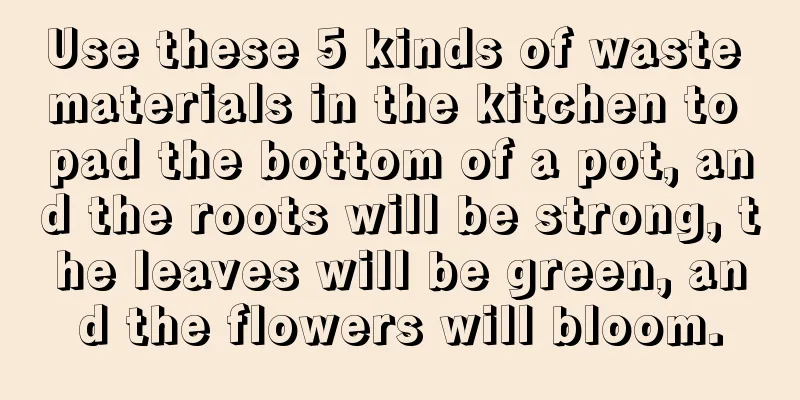Use these 5 kinds of waste materials in the kitchen to pad the bottom of a pot, and the roots will be strong, the leaves will be green, and the flowers will bloom.

Range hood wastes oilWhat women hate most is the oil waste in the range hood. It is dirty and difficult to clean. In fact, we can use the oil in the oil storage box to grow flowers. Steps for growing flowers with a range hoodStep 1: Take out the waste oil in the range hood box, and be careful not to use other raw peanut oil, motor oil, diesel, etc. Step 2: Poke 4-5 small holes around the flowerpot along the wall. The depth of the holes should be about 5-8 cm and the diameter should be about 0.5-0.8 cm. Avoid poking the roots. Step 3: Pour about 0.5 cm of waste oil into the hole, then fill it with soil to cover the hole. Step 4: This method can be used for Kalanchoe, Christmas cactus, Clivia, Chlorophytum, Verbena, geranium, honeysuckle, etc., but should not be used for jasmine, gardenia, and green ivy. Seafood ShellsIt's summer, and it's the season for eating crayfish and various seafood. It would be a waste if you just throw away the shells of the seafood after eating them. In fact, seafood shells are very good phosphorus and potassium fertilizers. Using them on flowers can ensure that the flowers are large and colorful, and the branches are full of flowers. Steps for growing flowers with seafood shellsStep 1: When eating crayfish or other seafood, leave the head and skin on. Step 2: Put the seafood shells in a wok, stir-fry over low heat, slowly mash and crush them until the seafood shells are very crispy, then turn off the heat and cool. Step 3: Smash the cooled seafood shells with a hammer or place them on the road to be crushed by a car until they become powder. Then spread it out in the sun for 1-2 weeks. Step 4: Before planting flowers, spread a layer of soil at the bottom of the pot, sprinkle a layer of seafood shell powder, cover with another layer of soil, and then plant the flowers. You can also mix the seafood shell powder and soil directly together. Not only will it not burn the roots, it is also nutritious, loose and breathable, and easy to use! Notice: Shrimp and crab shells that can be used to grow flowers must be boiled or steamed, not braised. baking sodaMany people don’t know that baking soda, which is usually used in cooking, is also a very good material for growing flowers. So, if you have baking soda that has not been used for a long time or attracts insects, don’t throw it away. Use it to grow flowers. How to use baking soda to grow flowersThe first usage: Baking soda can prevent and control flower diseases and pests, and can prevent and control powdery mildew and anthracnose of flowers such as roses, orchids, rhododendrons, and pomegranates. The method is to mix 3 grams of baking soda and 1 kilogram of water, and spray it on the front and back of the leaves. It can be used 1-2 times a week. Second usage: Baking soda is alkaline and can be used to irrigate the roots of cacti, begonias, hydrangeas and other flowers that like alkaline soil. To use, mix 50 ml of baking soda with 4 liters of water and water the flowers once a month. The third usage: Baking soda can deodorize. When fermenting bean cake water or rice water, you can pour 1-3 spoons of baking soda into the bottle. There will be no smell or odor during the fermentation process. |
<<: Our whole summer is occupied by these flowers
Recommend
These 17 Chinese rose species have large and full flowers, much more beautiful than European roses!
Soft fragrant red Soft and Fragrant Red is a clas...
Causes and treatments of yellow leaves of desert rose
1. Insufficient light 1. Reason: The growth of de...
How to propagate sea daffodils
1. Seeding method This method usually involves ha...
How to grow and water lilies
The ideal growth temperature range for lilies is ...
What is the reason for the rot spots on the leaves of Tiger Pilan
1. Too much watering Reason: The root system of S...
Can Desert Rose be repotted in summer? What should be paid attention to when repotting?
Can Desert Rose be repotted in summer? Desert ros...
What is the best month to plant bitter chrysanthemum?
When to plant bitter chrysanthemum Gewurze is a v...
The role and efficacy of Imperata root
1. Function and efficacy: 1. Therapeutic effects:...
How to propagate climbing roses? Can they be grown by cuttings?
1. Grafting propagation 1. Preparation: Climbing ...
Do mulberry trees prefer shade or sun?
Do mulberry trees prefer shade or sun? Mulberry t...
How to fill the pot with soil
How to fill a square pot with soil First you need...
The effect of drinking golden lotus soaked in water
Treating chronic tonsils with golden lotus soaked...
Early Spring Carrot Planting Time and Method
Early spring carrots are carrot varieties that ar...
How to grow azalea (home growing method)
1. Breeding methods 1. Sunlight: Rhododendron is ...
What pests does Tigerthorn have?
1. Whitefly 1. Harm: After whiteflies appear, the...









